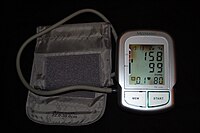
Photo from wikipedia
Background: Hypertension is common in older individuals and is a major risk factor for cardiovascular disease. Blood DNA methylation profiles have been used to derive metrics of biological age that… Click to show full abstract
Background: Hypertension is common in older individuals and is a major risk factor for cardiovascular disease. Blood DNA methylation profiles have been used to derive metrics of biological age that capture age-related physiological change, disease risk, and mortality. The relationships between hypertension and DNA methylation-based biological age metrics have yet to be carefully described. Methods: Among 4419 women enrolled in the prospective Sister Study cohort, DNA methylation data generated from whole blood samples collected at baseline were used to calculate 3 biological age metrics (PhenoAgeAccel, GrimAgeAccel, DunedinPACE). Women were classified as hypertensive at baseline if they had high blood pressure (systolic blood pressure ≥140 mm Hg or diastolic blood pressure ≥90 mm Hg) or reported current use of antihypertensive medication. New incident cases of hypertension during follow-up were identified via self-report on annual health questionnaires. Results: All 3 DNA methylation metrics of biological age were positively associated with prevalent hypertension at baseline (per 1-SD increase; PhenoAgeAccel, adjusted odds ratio, 1.16 [95% CI, 1.05–1.28]; GrimAgeAccel, adjusted odds ratio, 1.28 [95% CI, 1.14–1.45]; DunedinPACE, adjusted odds ratio, 1.16 [95% CI, 1.03–1.30]). Among 2610 women who were normotensive at baseline, women with higher biological age were more likely to be diagnosed with incident hypertension (per 1-SD increase; PhenoAgeAccel, adjusted hazard ratio, 1.09 [95% CI, 0.97–1.23]; GrimAgeAccel, adjusted hazard ratio, 1.16 [95% CI, 0.99–1.36]; DunedinPACE, adjusted hazard ratio, 1.16 [95% CI, 1.01–1.33]). Conclusions: Methylation-based biological age metrics increase before a hypertension diagnosis and appear to remain elevated in the years after clinical diagnosis and treatment.
Journal Title: Hypertension
Year Published: 2023
Link to full text (if available)
Share on Social Media: Sign Up to like & get
recommendations!